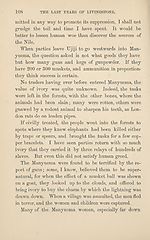Download files
Complete book:
Individual page:
Thumbnail gallery: Grid view | List view

THE LAST YEARS OF LIVINGSTONE.
109
the Lualaba, are very light coloured and lovely. It was
common to hear the Zanzibar slaves—whose faces resemble
the features of London door-knockers, which some atrocious
ironfounder thought were like those of lions—say to each
other, “ Oh, if we had Manyuema wives, what pretty
children we should get! ”
Manyuema men and women were all vastly superior to
the slaves, who evidently felt the inferiority they had ac¬
quired by wallt^ving in the mire of bondage. Many of the
men were tall, strapping fellows, with but little of what
we think distinctive of the negro about them. If one re¬
lied on the teachings of phrenology, the Manyuema men
would take a high place in the human family. They felt
their superiority, and often said truly, “ Were it not for
fire-arms, not one of the strangers would ever leave our
country.”
If a comparison were instituted, and Manyuema, taken
at random, placed opposite, say, the members of the An¬
thropological Society of London, clad like them in kilts
of grass cloth, I should like to take my place along¬
side the Manyuema, on the principle of preferring the
company of my betters ; the philosophers would look woe¬
fully scraggy. But though the “inferior race,” as we com¬
passionately call them, have finely-formed heads, and of¬
ten handsome features, they are undoubtedly cannibals.
It was more difficult to ascertain this than may be ima¬
gined. Some think that they can detect the gnawings of
our cannibal ancestry on fossil bones, though the canine
teeth of dogs are pretty much like the human,
109
the Lualaba, are very light coloured and lovely. It was
common to hear the Zanzibar slaves—whose faces resemble
the features of London door-knockers, which some atrocious
ironfounder thought were like those of lions—say to each
other, “ Oh, if we had Manyuema wives, what pretty
children we should get! ”
Manyuema men and women were all vastly superior to
the slaves, who evidently felt the inferiority they had ac¬
quired by wallt^ving in the mire of bondage. Many of the
men were tall, strapping fellows, with but little of what
we think distinctive of the negro about them. If one re¬
lied on the teachings of phrenology, the Manyuema men
would take a high place in the human family. They felt
their superiority, and often said truly, “ Were it not for
fire-arms, not one of the strangers would ever leave our
country.”
If a comparison were instituted, and Manyuema, taken
at random, placed opposite, say, the members of the An¬
thropological Society of London, clad like them in kilts
of grass cloth, I should like to take my place along¬
side the Manyuema, on the principle of preferring the
company of my betters ; the philosophers would look woe¬
fully scraggy. But though the “inferior race,” as we com¬
passionately call them, have finely-formed heads, and of¬
ten handsome features, they are undoubtedly cannibals.
It was more difficult to ascertain this than may be ima¬
gined. Some think that they can detect the gnawings of
our cannibal ancestry on fossil bones, though the canine
teeth of dogs are pretty much like the human,
Set display mode to:
![]() Universal Viewer |
Universal Viewer | ![]() Mirador |
Large image | Transcription
Mirador |
Large image | Transcription
| Antiquarian books of Scotland > Scotland/Scots > Last years of Livingstone > (117) |
|---|
| Permanent URL | https://digital.nls.uk/136058566 |
|---|
| Description | Thousands of printed books from the Antiquarian Books of Scotland collection which dates from 1641 to the 1980s. The collection consists of 14,800 books which were published in Scotland or have a Scottish connection, e.g. through the author, printer or owner. Subjects covered include sport, education, diseases, adventure, occupations, Jacobites, politics and religion. Among the 29 languages represented are English, Gaelic, Italian, French, Russian and Swedish. |
|---|

